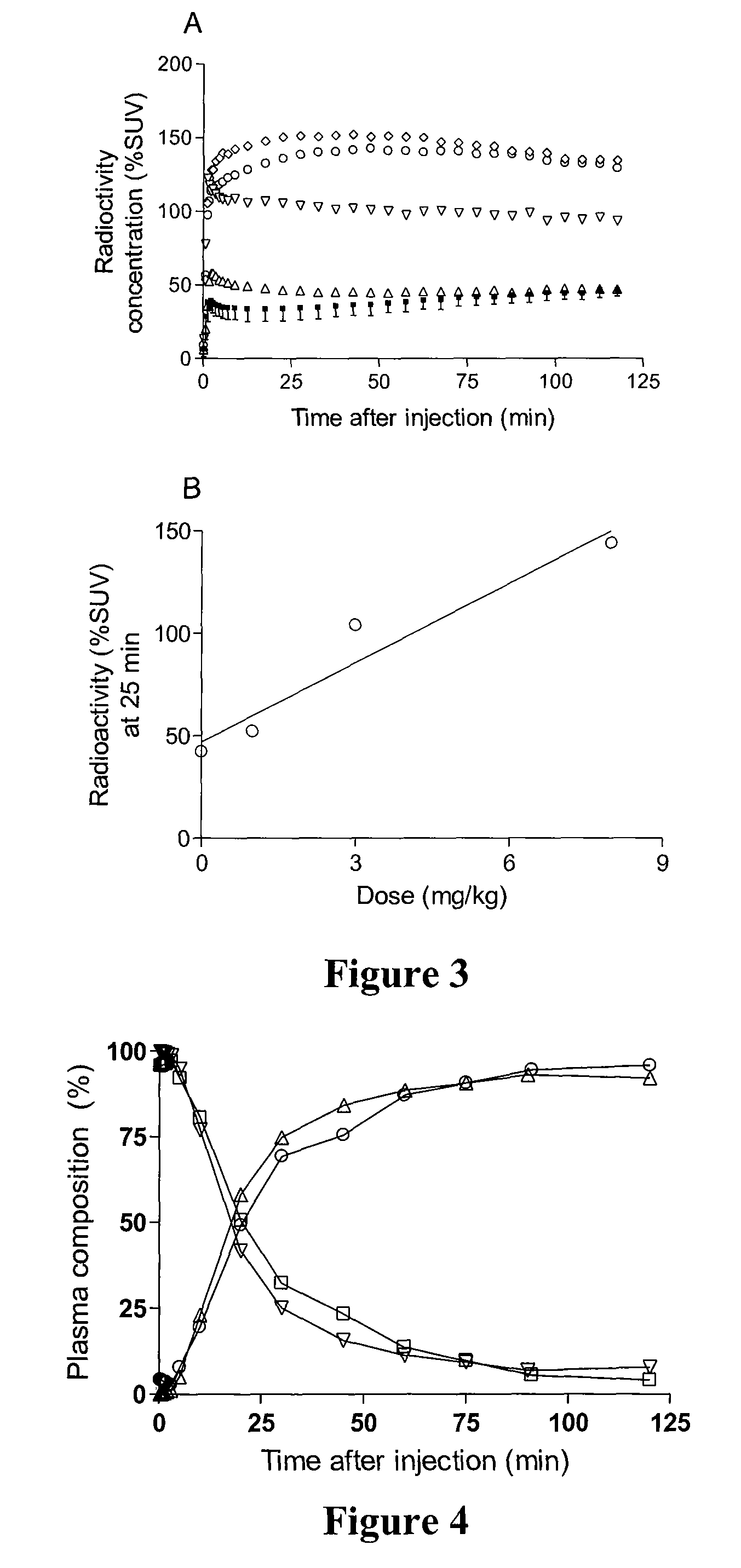Radiotracers for imaging P-glycoprotein function
a radiotracer and function technology, applied in the field of radiotracers and radiolabeled compounds, can solve the problems of insufficient confidence, inability to establish the change in p-gp function with sufficient confidence, and inability to meet the requirements of establishing the required dose of a p-gp inhibitor or competitive substra
- Summary
- Abstract
- Description
- Claims
- Application Information
AI Technical Summary
Benefits of technology
Problems solved by technology
Method used
Image
Examples
example 1
General Methods
[0386](a) Reagents and Reactions
[0387]All reagents and organic solvents were ACS grade or higher and were used without further purification. 4 (4-chlorophenyl)-4-hydroxypiperidine, 4-bromo-2,2-diphenylbutyronitrile and N,N-di-isopropylethylamine (DIPEA) were purchased from Aldrich (Milwaukee, Wis.). DCPQ ((2R)-anti-5-{3-[4-(10,11-dichloromethanodibenzo-suber-5-yl)piperazin-1-yl]-2-hydroxypropoxy}quinoline trihydrochloride (Pfister et al., 1995, Bioorg Med Chem Lett 5:2473-2476) was a gift from Eli Lilly (Indianapolis, Ind.). Reactions were performed under argon atmosphere with standard Schlenk techniques.
[0388]For some studies, GlaxoSmithKline provided N-desmethyl-loperamide, the precursor for synthesis of 11C-loperamide. Eli Lilly provided DCPQ [(2R)-anti-5-{3-[4-(10,11-dichloromethanodibenzo-suber-5-yl)piperazin-1-yl]-2-hydroxypropoxy}quinoline trihydrochloride], which is a potent inhibitor of P-gp. DCPQ was previously reported as compound 14b (Pfister et al., 1995,...
example 2
Synthesis of 11C Loperamide
[0404]11C-Loperamide (Wilson et al., 2005, J Label Compd Radiopharm 48:S142) was prepared automatically within a lead-shielded hot cell from cyclotron-produced 11C-carbon dioxide in a commercial apparatus (Mel Microlab; Bioscan, Washington D.C., USA). 11C-Carbon dioxide (51.8 GBq) was produced according to the 14N(p,α)11C reaction by irradiating nitrogen that contained oxygen (1%) for 20 min at an initial pressure of 11 atmospheres with a proton beam (16.5 MeV; 45 μA) using a PETrace cyclotron (GE Healthcare, USA). The 11C-carbon dioxide was reduced to 11C-methane and further to 11C-iodomethane by repetitive high temperature direct iodinations (Larsen et al., 1997, Appl Radiat Isot 48:153-157). The 11C-iodomethane was then released from this apparatus in a stream of He (15 mL / min) into a PLC-controlled semi-robotic Synthia apparatus (Synthia, Uppsala University PET Centre, Uppsala, Sweden). The helium containing 11C-iodomethane was bubbled into a septum-se...
example 3
[0407]The affinity of loperamide and dLop at three opiate receptors (delta, kappa, and mu) was measured using radiolabeled agonists for each receptor subtype. Detailed binding protocols are available on the web site for The National Institute of Mental Health Psychoactive Drug Screening Program.
[0408]Loperamide and dLop had high affinity and quite high selectivity for binding to opiate receptors over δ and κ subtypes (Table 1). Loperamide is an agonist; therefore its affinity was measured using agonist radiotracers.
[0409]Table 1 shows the affinity of loperamide and dLop for three cloned human opiate receptor subtypes:
[0410]
AgonistKi (nM)*ReceptorRadiotracerLoperamidedLopμ3H-DAMGO0.31 ± 0.030.56 ± 0.05δ3H-DADLE116 ± 7 328 ± 22 κ3H-U69,59347 ± 4 73 ± 7 *Ki (inhibition constants) values are the mean ± SD of four competitive binding experiments.
PUM
| Property | Measurement | Unit |
|---|---|---|
| time | aaaaa | aaaaa |
| time | aaaaa | aaaaa |
| time | aaaaa | aaaaa |
Abstract
Description
Claims
Application Information
 Login to View More
Login to View More - R&D
- Intellectual Property
- Life Sciences
- Materials
- Tech Scout
- Unparalleled Data Quality
- Higher Quality Content
- 60% Fewer Hallucinations
Browse by: Latest US Patents, China's latest patents, Technical Efficacy Thesaurus, Application Domain, Technology Topic, Popular Technical Reports.
© 2025 PatSnap. All rights reserved.Legal|Privacy policy|Modern Slavery Act Transparency Statement|Sitemap|About US| Contact US: help@patsnap.com



